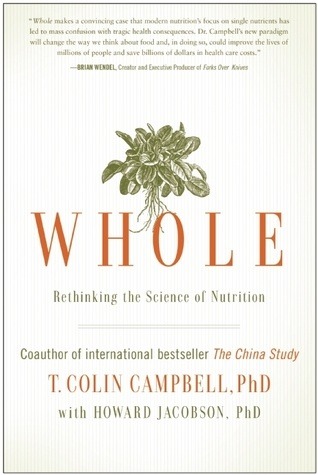More on this book
Community
Kindle Notes & Highlights
Rather than focus on the underlying cause, Western medicine has decided to focus on the individual symptoms and call each of them a disease. And admittedly, it’s good business to identify thousands of different diseases, then make and sell treatments for each of them, rather than to look at the big picture and prescribe one simple intervention that helps them all. But it’s not good medicine.
The most significant carcinogen, the substance that almost invariably led
to cancer at 20 percent of the rats’ diet, was casein, or milk protein. Plant proteins, such as those from wheat and soy, had no effect on cancer development, even at high levels.
Western medicine views the body geographically; it treats the liver, the kidney, the heart, the left patella, and so on. Chinese medicine, by contrast, sees the body as an energetic network.
an apple does a lot more inside our bodies than all the known apple nutrients ingested in pill form. The whole apple is far more than the sum of its parts. Thanks to the reductionist worldview, however, we don’t really believe the food itself is important. Only the nutrients contained in the food matter.
When we eat the right foods, our bodies naturally tend toward homeostasis.
Population studies begun forty to fifty years ago show that when people migrate from one country to another, they acquire the cancer rate of the country to which they move, despite the fact their genes remain the same. This strongly indicates that at least 80 percent to 90 percent—and probably closer to 97 percent to 98 percent—of all cancers are related to diet and lifestyle, not to genes.
I started to see that none of the accepted “causes” of cancer, in the absence of a high-animal-protein diet, mattered that much. Not genetics, not chemical carcinogens like AF, not viruses. But the cancer industry, researchers, policy makers, the media, and the public focus almost exclusively on genes, chemicals, and viruses.
the so-called health-care system in the United States doesn’t really have much to do with health. Instead, it’s more properly called a disease-care system, because it just reacts to and manages disease, producing the expensive and disappointing outcomes we’ve come to tolerate and expect without knowing there’s another, better way.
Under the reductionist mindset, healthy eating becomes a crapshoot of nutrient micromanagement—a list of individual nutrients that must be consumed in specific, regimented quantities. But in nature, you don’t find beta-carotene on its own. You can’t cut a slice of beta-carotene out of a carrot.
In a world where millions of people die of starvation and starvation-related diseases every year, we still inexplicably insist on the gross inefficiency of cycling our plant production through animals before considering it “food.” Feeding meat-producing animals rather than feeding humans directly means we lose upward of 90 percent of the calories otherwise available for our consumption.
Lobbyists representing dairy, meat, sugar, and other processed foodstuffs all but write government regulations and control the bulk of nutrition-related messaging. Our school lunch programs highlight the government’s lack of commitment to instilling healthy eating habits in our population.
Why bother to think about something when you won’t get the funding to pursue your research? Why build a career on questions that no one will pay for you to investigate? So already the system is excluding questions about how to get more people to eat healthy
The medical, pharmaceutical, and supplement industries figured out long ago that a nation of healthy eaters would be disastrous to their profits.
Big Pharma spends, as of 2004, an average of $61,000 per year, per each and every physician in the country, to promote its products.
Can you imagine the health gains in the U.S. population if the half-trillion dollars in annual Big Pharma revenue were allocated to educating the public about WFPB nutrition, and to making sure that fresh, organic, sustainably grown produce were available and affordable for all Americans?
medical journals make a lot of money when they please Big Pharma. Professional journals, like mainstream newspapers and magazines, are funded in large part by advertising.
We coauthored a retrospective analysis of the dramatic effects of his fasting program on his clients with hypertension.5 Every one of the 176 successive patients who were analyzed for the paper experienced a drop in blood pressure, most of which began within a few days of beginning the fast. The effect occurred relatively rapidly, was more substantial than that produced by any antihypertensive drug ever tested, and was free of side effects. It proved to be an unusually effective intervention. But journals like JAMA and NEJM, whose income depends on heavy advertising from antihypertensive
...more
Big Pharma, Big Insurance, and Big Medicine are among the biggest contributors to U.S. political candidates.
Our bodies, on their own, produce all the cholesterol we need.
“physician error, medication error and adverse events from drugs and surgery”15 is the third leading cause of death, trailing just heart disease and cancer. These are deaths caused by the medical system, almost half of which result from the adverse effects of prescription drugs.
Mammography, the most common and lucrative form of breast cancer screening, is one of the pillars of ACS practice and philosophy. Epstein points out that five past presidents of ACS
have been radiologists, and DuPont, a manufacturer of mammogram film, heavily funds the ACS Breast Health Awareness Program.
There is impressive evidence that high levels of milk consumption correlate with high rates of MS prevalence,
our reverence for animal protein. Our society believes so passionately in the health value of milk and meat that it is hard for us to conceive that we might be wrong


